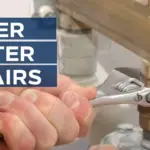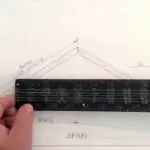So, you’ve got a soil that has low bearing capacity and you’re left with an option either to have a deep basement or to go with any type of mat foundation or raft foundation. Whether you’re constructing a building, or you need to support loads from the storage tanks, industrial equipment, chimneys, or even silos; it’s pretty important to know different types of mat foundation.
I’ve tried to explain all the different types with sketches and diagrams so that you can easily understand.
The decision of picking the right type of raft foundation is quite overwhelming and you need to know the advantages and disadvantages of all of them.

Where Raft foundation is used?
If you’re wondering where raft foundations are used, here’s a kicker. Raft foundation, also known as matt foundation, is a reinforced concrete slab that can be rectangular or circular in plan. It’s a thick reinforced concrete slab that embeds the reinforcement of frame structure. It takes the load from the columns of superstructure and distributes the loads over a larger area.
Due to such characteristics, the foundation is often used in areas where the bearing capacity of soil is weak and you have got heavy loads to support like in industrial foundation, buildings, or storage tanks.
Advantages of raft foundation
The main advantage of raft foundation is its quick construction and cheaper construction as compared with other type of footings.
How do raft foundations work?
Do you know why raft foundation is actually called a raft foundation? The answer is quite interesting and that’s because of the working principle. Raft we all know is a flat buoyant structure of timber of some other material that is used to travel over water. It’s a bit different than boat but serves the same purpose. Now as the raft floats over water the raft foundation also bridges the poor patches in the underneath soil and distributes the load over larger area.
So even if you’ve got some poor patches in the underneath soil, the raft will cover them up and distribute the load to the adjacent soils. From the basics of bearing capacity of soil you already know that in order to enhance the bearing capacity you either have to make foundations deep or you can increase the site of footing to increase the allowable stresses on the foundation. So, in the case of raft you do the second trick.
The stress on the soil is given by the force on the foundation divided by the area of footing. The load on the raft is the self-weight and the weight of the super structure or a building. Now as the contact area of the foundation has been increased, the stress on the soil is reduced. Resultantly, you don’t have to worry about shear failure or differential settlement.
Different types of raft foundation
Now that you’ve learnt the basics, let’s head on to our main topic for this post which is about the different type of raft foundation.
There are six major types of raft foundation these are:
- Solid slab rafts or solid raft foundation
- Slab beam rafts (two-way beam and slab raft)
- Wide Toe Raft
- Plate raft with pedestals
- Cellular rafts or rigid frame mat
- Piled raft foundation
- Balancing or floating rafts
Solid slab rafts or solid raft foundation
As the name suggests, this type of mat foundation is like a flat solid plate and have a uniform thickness throughout. It’s the most common type and generally the thickness in such foundation is restricted within 300mm otherwise it will not be economical. However, this type of foundation is only used when the columns and load bearing walls are spaced at small equal intervals and the loads are relatively lesser. Both main and shrinkage reinforcement is provided at top and bottom in the detailed design and if required, the designer may place more reinforcement at the location of columns and load-bearing walls.
Plate raft with pedestals
When you’re looking to support heavier column loads and the thickness of the raft doesn’t satisfy the load requirements a simple solution is to make the slab thicker under columns and load bearing walls. Sometimes extra or negative reinforcement is provided to resist diagonal shear stresses.
Wide Toe raft
Another way of increasing the stiffness is by providing a wide reinforced toe at the external leaf that extends as a base. The minimum depth of such a stiffening edge beam is taken as 750 mm and this allows the outer bricks to be finished below ground.
Slab beam rafts (two-way beam and slab raft)
If the columns are placed at a larger distance and have unequal distributed loads to resist you may have to add concrete ground beams monolithically with the slab. This increases the stiffness required in such a condition. The columns in such a foundation rest directly on top of the reinforced ground beams and in this way the bearing capacity is increased. The raft foundation typically spans over the ground beams.
Cellular rafts or rigid frame mat
Another way of enhancing the bearing capacity of matt foundation is by combining two concrete slabs locked together via ground beams. Cellular rafts also known rigid frame mat are exceptionally rigid and that’s why designers prefer it for situations where one has to deal with uneven settlement or where heavy loads are anticipated. Another situation where cellular rafts are preferred is the case of ground heave which can otherwise cause problems.
Piled raft foundation
When you’re looking to construct a high-rise building but the raft foundation doesn’t fit in your loading requirements, you may have to add enhancements. One of enhance performance and avoid differential settlement is by introducing piles underneath the mat foundation. It will ultimately increase the bearing capacity of your raft foundation and such a type is called piled raft foundation.
Balancing or floating rafts
In foundations the word “floating” explains the load mechanism. In such a foundation the load of the soil removed is equal to the load of the structure including foundation. A balancing raft is the same type and is only used when the bearing capacity of the soil is way too low. Such a foundation is not always cost-effective as you have to go deep into the soil and provide earth supporting structure or sometimes retaining walls.
Blanket raft
It’s a rather uncommon type of raft or matt foundation. This type is predominantly used in areas with weaker soil or where different types of soil are present. In order to provide an even load support in such situations, a stone blanket is provided on the prepared ground in layers upto to the desires level (design level). Upon this blanket a concrete crust raft is constructed. The blanket and the crust interact to support and span the loading over poor patches of underneath soils.
Slip plane raft
In a slip plane type rafts an initial substrata or slip layer is provided which is mostly a sand layer. The thickness of the sand layer or slip-plane is a critical design parameter and it generally extends beyond the raft foundation.

















